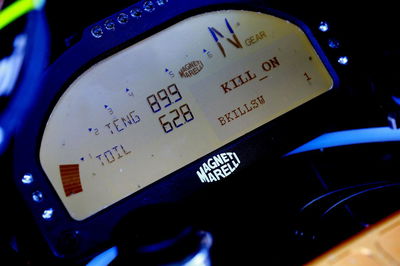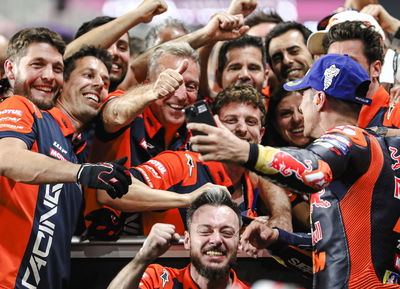MotoGP set to debut dashboard messages

An advanced form of dashboard communication is set to be trialed at a MotoGP round before the end of 2016, race director Mike Webb has confirmed.
The system will allow teams to send 'simple' text messages to their riders once they leave the confines of pit lane. The technology is ready to be sampled during free practice at the upcoming rounds, with this trial a precursor to introducing the system throughout the premier class in 2017.
"The trial is before the end of the year," explained Webb, "but certainly not applied throughout the class. It's a winter project with trials before the end of the season to make sure we're on the right track."
At present, riders receive basic messages on their dashboards, to warn them of a red or black flag for instance, or indeed signals that indicate they have incurred a ride-through penalty.
But this new system could allow riders to receive additional messages from team personnel - such as an order to pit, or information relating to a rival's tyre choice during a flag-to-flag race.
Webb has said "the technology is ready to go." Now IRTA (International Roadracing Teams Association) is awaiting MotoGP teams to compile a list of what they feel to be appropriate messages for such situations.
It will then be the job of series organiser Dorna's technical team, timekeeping and race direction to decide which of these messages are relevant and applicable to a practice or race setting.
"It's well underway," said Webb at the close of the Aragon weekend. "At this point the technology is ready to go. Again with proviso that it takes time for the dashboard manufactures to get ready for it, once we've told them exactly what we want, but technically it's ready.
"IRTA and the IRTA committee has asked all of the teams to propose what messages they would like to use, and then between the technical people at Dorna, timekeeping, who are running the message system and Race Direction, have whittled it down to a really small number of messages that are useful that are basically globally applicable.
"That'll be the choice of messages that can be used. So it's getting close to done. Since we haven't received all the messages from the teams I'm sure a number of the messages will be, 'X rider is using intermediate tyres'.
"Typically the thing everyone's focusing on is most flag-to-flag races, is to give riders information about when it's good to come in."
In mid-August race direction explained how, once the system is ready for full integration, the messages could add to the televisual dynamic, with the team's messages displayed on a viewer's screen at home, as well as a rider's dashboard.
It was then that Webb spoke of his apprehension at implementing an overly complicated system, believing it may deprive the sport of its total emphasis on a rider's ability to make almost all key decisions during a race, a facet that differentiates MotoGP from Formula 1, a view that he still shares.
"We're trying to keep it simple. We've had similar discussions before where I'm very reluctant to add a load of complexity. I very much like the sporting aspect of Grand Prix motorcycle racing that it's a rider and a machine out there doing this chicane with what he's got, rather than a lot of outside influence.
"So we try to keep it pure while giving some sensible information to the riders. Things like what the track condition is, that sort of thing where safety comes into it. Like riding, a section where the riders exiting the pits don't even know which tyres their bike had on. Stuff where the team could relay that to them."
The idea received a mixed reception from the MotoGP grid when floated at the Austrian Grand Prix in mid-August. Valentino Rossi was a keen advocate, saying, "It can also be good for the safety. If you have some problem with the engine, or with the oil, it's OK." Others, namely Marc Marquez and Eugene Laverty, felt the feature would be an unnecessary distraction.
"What did Laverty say?" smiled Webb, recalling the Northern Irishman's comments, which poked fun at the need for this system when a pit board effectively relays crucial information once a lap.
"I had my doubts about going down a road where we get too complex and too reliant on this, remembering that it's not 100% reliable. It might fail at some point. The transponder might not pick up.
"So I want it to be as simple as possible, if we're going to go ahead with it, and one of those things that it's extra information and if a rider chooses to use it, to read it, that's fine. But it's not mission critical, as in you can go and race without it."
Webb also confirmed that certain riders have been trialing a system that sends a simple warning to riders repeatedly exceeding track limits, an issue that came to the fore during the race weekend at Misano.
Unlike the messages discussed earlier, these warnings have been sent from race direction to "a handful of riders" during preliminary tests. Webb is confident dashboard software will be able to offer these warnings to all riders by the time they take to the Motegi track in Japan on Friday.
"What we've done to make sure the technology on the dashboard works and that the rider recognizes it for what it is - because I don't want to sow confusion in the poor little dears' minds! So we've just made sure that yes, the signal works. The dashboard manufacturer has been able to make it do what we want it to do. We've done that with a handful of riders.
"I wanted to make sure we're not confusing anyone, because the track limit signal we intend to send is a warning saying, 'hey, pay attention. You've been out once or twice, but take it easy so you don't get a penalty'.
"Whereas every other signal that's currently in use on the dashboard and works really well, is a penalty, is a directive. Red flag, stop. Black flag, get in the pits. Black and orange flag, your bike, get it off the track. Stuff that they have to do something. I didn't want to have confusion."
"It's simply logistics of having each of the dashboard manufacturers have the required software update that will work with our system to show that signal. It should be in place by Japan. We'll use it as soon as we can, when it's available for everyone."











